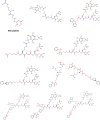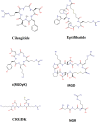RGD peptide in cancer targeting: Benefits, challenges, solutions, and possible integrin-RGD interactions
- PMID: 38349028
- PMCID: PMC10832341
- DOI: 10.1002/cam4.6800
RGD peptide in cancer targeting: Benefits, challenges, solutions, and possible integrin-RGD interactions
Abstract
RGD peptide can be found in cell adhesion and signaling proteins, such as fibronectin, vitronectin, and fibrinogen. RGD peptides' principal function is to facilitate cell adhesion by interacting with integrin receptors on the cell surface. They have been intensively researched for use in biotechnology and medicine, including incorporation into biomaterials, conjugation to medicinal molecules or nanoparticles, and labeling with imaging agents. RGD peptides can be utilized to specifically target cancer cells and the tumor vasculature by engaging with these integrins, improving drug delivery efficiency and minimizing adverse effects on healthy tissues. RGD-functionalized drug carriers are a viable option for cancer therapy as this focused approach has demonstrated promise in the future. Writing a review on the RGD peptide can significantly influence how drugs are developed in the future by improving our understanding of the peptide, finding knowledge gaps, fostering innovation, and making drug design easier.
Keywords: RGD peptides; cancer targeting; challenges; conjugation process.
© 2024 The Authors. Cancer Medicine published by John Wiley & Sons Ltd.
Conflict of interest statement
The authors declare that they have no conflict of interest.
Figures
References
-
- Ruoslahti E, Pierschbacher MD. New perspectives in cell adhesion: RGD and Integrins. Science. 1987;238(4826):491‐497. - PubMed
Publication types
MeSH terms
Substances
LinkOut - more resources
Full Text Sources
Medical





